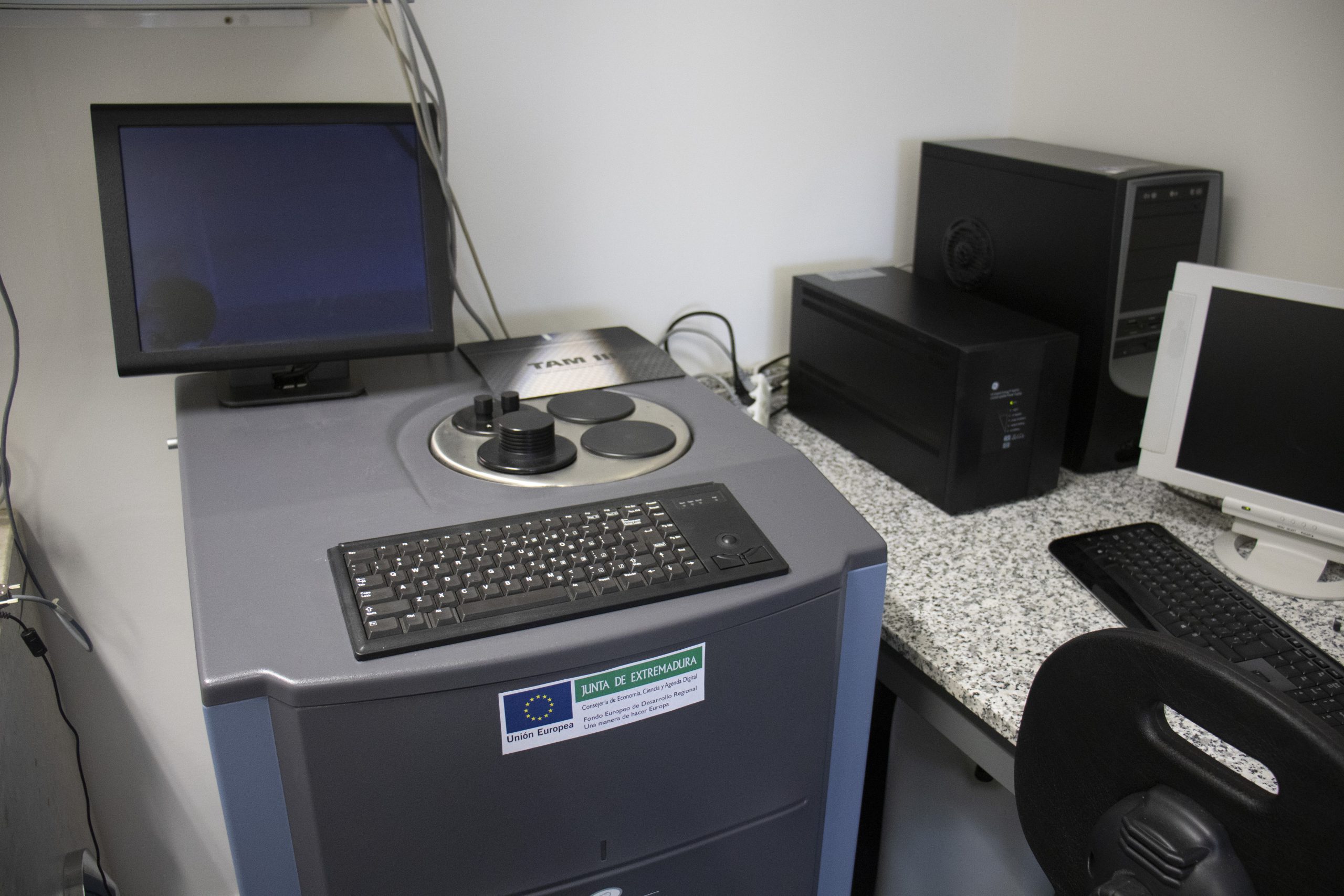U16-E01. TAM III isothermal nanocalorimeter system. (TA Instruments)
Temporarily OUT OF ORDER

Temporarily OUT OF ORDER

Temporarily OUT OF ORDER
Use of the system to measure the thickness of layers, and the composition, porosity and roughness of materials on a surface.
Tests in real time to measure:
·· Molecule-molecule interactions: Protein-protein, Receptor-ligand, Antibody-antigen, Biomaterial-molecule interactions, Biomaterial-cell interactions.
·· Microbial growth.
·· Cell metabolism.
Experiments of stability, growth,
etc, perfusion and dilution
Surface analysis of organic and inorganic materials (mass spectrum), map of chemical elements present in the surface of the sample (image), profile analysis shows sample analysis in depth.
Magnetometry on nanoparticles in solid form, ultra thin films, powders, liquids and even slurries:
Measurements of magnetic properties of materials:
Geophysical Research:
Biomedical Research:
Measurement of the relaxation times in aqueous solutions and biological samples containing superparamagnetic nanoparticles as contrast agents for MR images. For T1 in the continuous range 10 kHz to 80MHz; for T2 in the range 10 MHz to 80MHz.
Characterization of contrast agents for MR imaging, ascertaining their relaxivity and the dominant effect.
NMR relaxometry technique is an important analytical tool for NMR research and material characterization in both industrial and academic environments and has been successfully applied in a wide range of fields:
– Pharmaceutical Applications:
– Polymers Applications:
– Oil, gas and petroleum applications:
T1 and T2 Nuclear Magnetic Resonance Relaxometry:
Stelar SmarTRACER (Italy) + Bruker (Germany) 2 T electromagnet. Fast Field Cycling designed to measure longitudinal nuclear magnetic relaxation as a function of the magnetic field intensity. Measurements of the longitudinal (T1) and transverse (T2) time constants as a function of the Larmor frequency.
•• Measurement range: continuous measurement from 10 kHz (almost null field) to 10 MHz (0.25T) to obtain T1.
•• Measurement range: measurement from 10 MHz (0.25T) to 80MHz (1.9T) at desired intervals to obtain T1 and T2.
•• Inhomogeneity lower than 150 PPM.
•• Main pulse sequences implemented with the possibility of modifying parameters to the design and programming of new sequences.
•• Temperature control from -120°C to +140°C with accuracy and stability of 0.1°C.
Alternating Gradient Magnetometer:
MicroMag M2900-4 AGM (Princeton Measurements Corporation, USA) for the magnetic and mechanical characterization of nanoparticles in various different media:
•• Magnetic Moment Range: 1nA.m² to 5mA.m² full scale (1μemu to 5emu).
•• Resolution: 0,005% of full scale with 60% overrange capability.
•• Speed of measurement: 100 ms/point.
•• High sensitivity: 10 pA.m² (10 nemu) of standard deviation at room temperature and with 1 second of averaging time.
•• High performance with samples of very small magnetization and dimensions (few nanometers).
•• The AGM can accommodate a large range of samples with widely different properties.
Specifications:
›› Three heads for injection of different materials:
•• Polymers
•• Ceramics
•• Living cells
›› Allowed viscosities ranging from 1 to 106 centipoises.
›› System for temperature and humidity control to enable the printing conditions to be adjusted. It is possible to create a microenvironment appropriate for each mixture of materials and proteins and to achieve high rates of cell viability.
›› Controlled by Software .
›› Visual monitoring system based on a digital camera, firewire cameras and high magnification lenses, with detection and measurement of colormetric/monochromatic variations.
›› Mapping system using a laser sensor for control of normal and extended working distances. It includes Target, Grid and Path mapping.
›› High-precision dispensing pump for dynamic control of the flow rate.
›› Position control system:
•• X/Y/Z accuracy: ±10 μm
•• X/Y reproducibility: ±2 μm
•• X/Y resolution: 0.5 μm
•• X/Y velocity: 304 mm/s (12”/s)
•• X/Y displacement: 304X 152 mm (12”X6”)
•• Z displacement: 101 mm (4”)
In addition, it should be noted that the system is sited in a clean room with a controlled environment and supply of the gases required for these tests.
